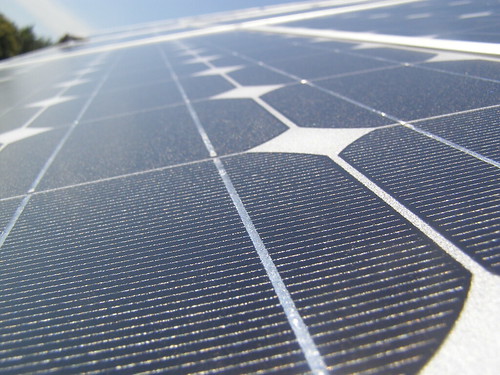Variable renewables: Benefits outweigh costs
Replacing fossil fuel power with variable wind and solar power means that more energy storage and power transmission capabilities are necessary. Despite this, we find large climate benefits and a range of other pollution benefits of switching to renewables.
The variability of wind and solar power makes their large-scale integration into power systems challenging. The wind does not blow on demand. The sun does not always shine. Still, power demand must be met at all times and for all locations. Our new study, lead-authored by one of our Master’s students last year, Peter Berrill, assesses the environmental impacts of high penetration renewable energy scenarios for Europe. By bringing together life cycle assessment (LCA) and power grid modelling, the study is able to capture both life cycle effects and variability issues in one single analysis.
While increased needs to store energy and to transfer electricity over large distances cause additional impacts in systems dominated by renewables, these impacts are small in comparison to the benefits of deploying renewables.
Former estimates present an incomplete picture
Results of LCAs are frequently used to compare the environmental performance of electricity generation options. One example is this graphic from the IPCC, juxtaposing life cycle emission estimates for different power generation options. However, these estimates do not consider impacts associated with accommodating large shares of variable supply in electricity networks.
Considering both life cycle effects and variability issues in one coherent assessment involves a substantial methods and data challenge. The basic reason for this is that impacts occurring as a result of variability is a property of whole systems, not of individual technologies.
How so? Well, we know that the wind does not always blow. This constitutes a challenge, because customer demand for electricity must always be satisfied. Now, we can deal with the challenge in a number of ways. We can expand transmission grids, to exploit the fact that the wind (almost) always blows somewhere. We can combine wind and solar deployment to reduce overall fluctuations. We can invest in energy storage, such as batteries or pumped hydro. We can invest in surplus capacity of flexible natural gas power, ready to be used when needed. Or – as will be the case in the real world – we can combine these measures in one way or another. Then, the impacts that arise as a result of variability depend on how all technologies are combined. The impacts cannot be determined by considering any single technology in isolation.
How we captured both life cycle effects and variability effects
In order to capture both life cycle effects and variability effects, you need both a power system model capable of simulating the operation of entire power systems, and an LCA model capable of estimating life cycle impacts of different power system layouts, and to combine the two in a sound manner.
Our study does exactly this. First, 44 scenarios describing power system configurations for Europe in 2050 were generated by a power system optimization model, REMix, operated by DLR in Germany. Next, the scenarios were examined using NTNU’s prospective LCA modelling framework, THEMIS. This combination allows us to present the first LCA of entire electricity systems while taking into account the effects of variability on storage and transmission requirements, and losses.
Our findings: Large climate benefits

The findings indicate large climate benefits and a range of other emissions reduction benefits of switching to renewables.
Adopting variable renewables on a large scale does lead to additional storage and transmission capacity requirements – and hence additional environmental impacts – but these are not large enough to significantly undermine the benefits of renewable power displacing fossil fuel-based power.
Another finding is that solar photovoltaic (PV) power tends to induce larger impacts than wind power, for two main reasons:
- The supply chains of solar power plants generally involve more emissions-intensive material processing and manufacturing activities than that of wind power plants.
- As wind power plants on average operate closer to their full capacity, systems dominated by wind power show lower needs for storage than solar-dominated systems.
Read more about our study in Environmental Research Letters.
This blog post was previously published in March 8th 2016 on www.ntnutechzone.no, and before that on Anders Arvesen’s blog.

Anders Arvesen
Anders Arvesen is a researcher at the Programme for Industrial Ecology and Department of Energy and Process Engineering – NTNU.
Tags In
Search
Søk
Categories
- Arctic Research
- Arkitektur
- Bærekraft
- Bioingeniørfag
- Biologi
- Biology
- Biomedical Laboratory Science
- Biotechnology
- Bioteknologi
- Chemical Engineering
- Chemistry
- Climate
- Computer Science
- Datateknologi
- Digital
- Elektronikk
- Energi
- Energi
- Energy
- Engineering
- Engineering
- Environment
- Food Science
- Forskning
- Fysikk
- Fysikk
- Havbruk
- Informasjonsteknologi
- Informasjonsteknologi
- Ingeniørvitenskap
- Kjemi
- Kjemisk prosessteknologi
- Kjemisk prosessteknologi
- Kreftbehandling
- Kybernetikk
- Marine Technology
- Materialer
- Materials Science
- Materialteknologi
- Matvitenskap
- Meninger
- Miljø
- Min ph.d.
- My PhD
- My PhD
- My postdoc
- Nanotechnology
- Nanoteknologi
- Ocean
- Oil and gas
- Physics
- Research
- Simulering og visualisering
- Spør en forsker
- Studentliv
- Sustainability
- Ukategorisert
- Universitetsliv
- University Life
Kategorier
- Arctic Research
- Arkitektur
- Bærekraft
- Bioingeniørfag
- Biologi
- Biology
- Biomedical Laboratory Science
- Biotechnology
- Bioteknologi
- Chemical Engineering
- Chemistry
- Climate
- Computer Science
- Datateknologi
- Digital
- Elektronikk
- Energi
- Energi
- Energy
- Engineering
- Engineering
- Environment
- Food Science
- Forskning
- Fysikk
- Fysikk
- Havbruk
- Informasjonsteknologi
- Informasjonsteknologi
- Ingeniørvitenskap
- Kjemi
- Kjemisk prosessteknologi
- Kjemisk prosessteknologi
- Kreftbehandling
- Kybernetikk
- Marine Technology
- Materialer
- Materials Science
- Materialteknologi
- Matvitenskap
- Meninger
- Miljø
- Min ph.d.
- My PhD
- My PhD
- My postdoc
- Nanotechnology
- Nanoteknologi
- Ocean
- Oil and gas
- Physics
- Research
- Simulering og visualisering
- Spør en forsker
- Studentliv
- Sustainability
- Ukategorisert
- Universitetsliv
- University Life


